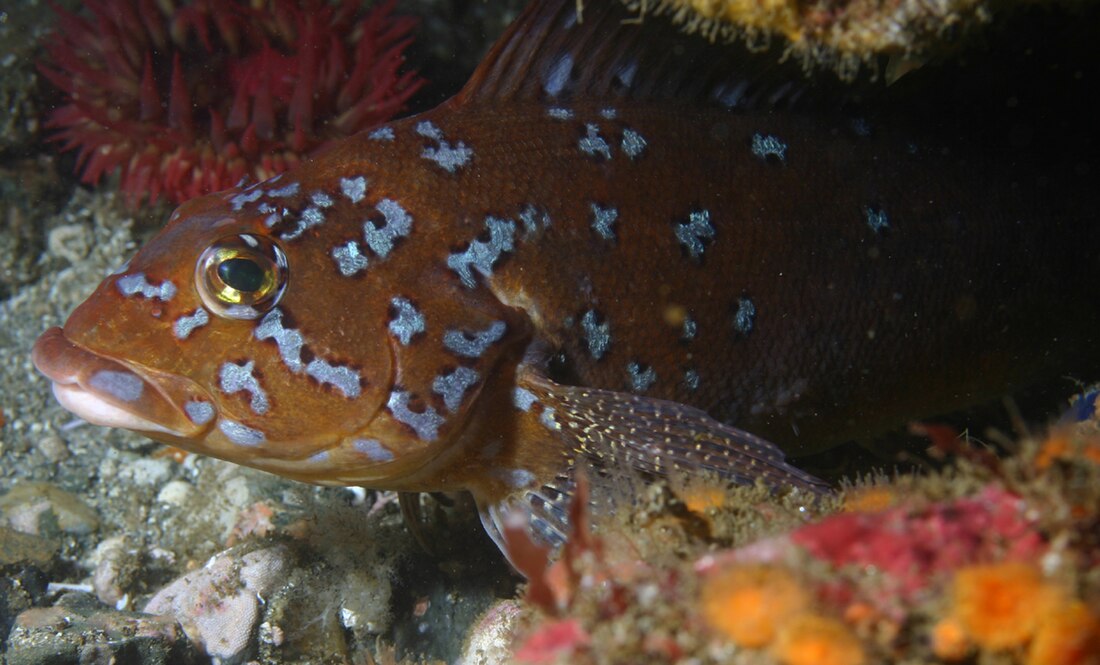Kelp greenling
Species of fish From Wikipedia, the free encyclopedia
The kelp greenling (Hexagrammos decagrammus) is a species of marine ray-finned fish belonging to the family Hexagrammidae, the greenlings. It occurs in the eastern Pacific Ocean
| Kelp greenling | |
|---|---|
 | |
 | |
| Male (top) and female (bottom) | |
| Scientific classification | |
| Domain: | Eukaryota |
| Kingdom: | Animalia |
| Phylum: | Chordata |
| Class: | Actinopterygii |
| Order: | Perciformes |
| Suborder: | Cottoidei |
| Family: | Hexagrammidae |
| Genus: | Hexagrammos |
| Species: | H. decagrammus |
| Binomial name | |
| Hexagrammos decagrammus (Pallas, 1810) | |
| Synonyms[2] | |
|
List
| |
Species description and etymology
The kelp greenling was first formally described in 1810 as Labrax decagrammus by the German naturalist Peter Simon Pallas with its type locality given as Cape St. Elias in Alaska.[3] The specific name, decagrammus, means "ten lines" refers to the 5 lateral line canals on each flank, giving a total of 10.[4]
Description
Kelp greenlings 21 or 22 spines in their first dorsal fin and 24 soft rays in their second dorsal fin while the anal fin contains a single spine and 23 or 24 soft rays.[2] The males are gray to brownish olive in color, dotted with irregular blue spots over the anterior half to two-thirds of their body. Each of these spots has a ring of small rusty spots around it. The females are also gray to brownish in color but they are marked all over with rust colored or golden spots. They have yellowish orange fins. In both males and females the inside of the oral cavity is yellowish and there is frequently and eye-like spot, an ocellus. at the rear of the second dorsal fin. There are five lateral lines on each flank, as well as a fleshy cirrhi over the eye with another halfway between the eye and the origin of the dorsal fin.[5] This species has a maximum published total length of 61 cm (24 in) and a maximum published weight of 2.1 kg (4.6 lb).[2]
Distribution and habitat
The kelp greenling is found in the eastern pacific Ocean where its range extends from the Aleutian Islands of Alaska to La Jolla in southern California. This species occurs in rocky nearshore areas of the northern is common on kelp beds and on sand bottoms.[2]
Biology
Kelp greenlings feed on crustaceans, polychaete worms, brittle stars, mollusks, and small fishes. The young are food for large predators such as steelhead and salmon.[2] Unique to this species is its mating ritual, where males attempt to inseminate eggs in the nests of other males. This phenomenon can be explained with condition dependent mating decisions.[6]
Fishing

This species is frequently caught by hook and line, fishing from shore or skiff, as well as speared by divers. They are commonly caught by fishermen targeting other species, and are often viewed as pests, despite their scrappy fight and tasty flesh. They are easily caught around rocky cliffs and kelp beds, and respond to a wide variety of natural and artificial baits.[2]
References
External links
Wikiwand - on
Seamless Wikipedia browsing. On steroids.

